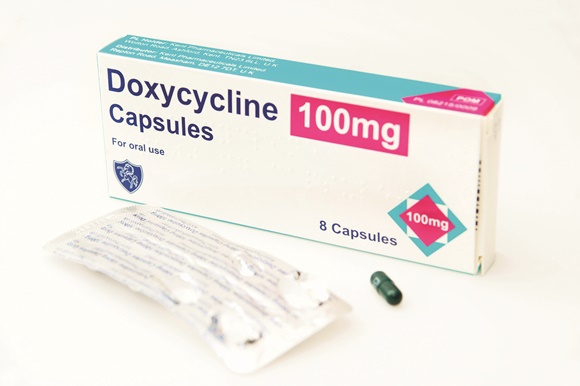Doxycycline is a broad-spectrum antibiotic synthetically derived from oxytetracycline label. This drug is a second-generation tetracycline, exhibiting lesser toxicity than first-generation tetracyclines. Doxycycline may be used to treat a wide range of bacterial infections, depending on the results of antibiotic susceptibility testing.
Doxycycline Mechanism Of Action
Doxycycline belongs to a class of drugs called tetracyclines. A class of drugs is a group of medications that work in a similar way. These drugs are often used to treat similar conditions. This drug works by blocking a bacterial protein from being made. It does this by binding to certain units of the protein. This stops the protein from growing and treats your infection. In gram-negative bacteria, transportation of the drug into the cell occurs either by passive diffusion or through an energy-dependent active transport system. The latter system is also believed to exist in gram-positive bacteria. Doxycycline and minocycline are more lipophilic than the other tetracyclines, which allows them to pass easily through the lipid bilayer of bacteria where reversible binding to the 30S ribosomal subunits occurs. Binding of doxycycline blocks the binding of aminoacyl transfer RNA (tRNA) to the messenger RNA (mRNA). Bacterial protein synthesis is inhibited, which ultimately accounts for the antibacterial action. High concentrations of antibiotic also can interfere with protein synthesis in mammalian cells, but these cells lack the active transport systems found in bacteria.
Can Doxycycline Treat UTI
A urinary tract infection (UTI) is an infection of the urinary system. This type of infection can involve your urethra (a condition called urethritis), kidneys (a condition called pyelonephritis) or bladder, (a condition called cystitis). Your urine typically doesn’t contain bacteria (germs). Urine is a byproduct of our filtration system—the kidneys. When waste products and excess water is removed from your blood by the kidneys, urine is created. Normally, urine moves through your urinary system without any contamination. However, bacteria can get into the urinary system from outside of the body, causing problems like infection and inflammation. This is a urinary tract infection (UTI).
Urinary tract infection (UTI) is a very common type of. A UTI can involve any part of your urinary system, including the urethra, ureters, bladder and kidneys. Symptoms typically include needing to urinate often, having pain when urinating and feeling pain in your side or lower back.
Most UTIs can be treated with an antibiotic. Which medication and dose you get depends on whether your infection is complicated or uncomplicated.
“Uncomplicated” means your urinary tract is normal. “Complicated” means you have a disease or problem with your urinary tract. You could have a narrowing of your ureters, which are the tubes that carry urine from your kidneys to your bladder, a narrowing in the urethra which transports urine from the bladder out of the body, or, you might have a blockage like a kidney stone or an enlarged prostate (in men).
Usual Adult Dose for Urinary Tract Infection
IV:
- Initial dose: 200 mg IV on the first day, given in 1 or 2 infusions
- Maintenance dose: 100 to 200 mg/day IV
ORAL:
Most Products:
- Initial dose: 200 mg orally on the first day, given in 2 divided doses (100 mg every 12 hours)
- Maintenance dose: 100 mg orally once a day OR 50 mg orally every 12 hours
- More severe infections (especially chronic urinary tract infections): 100 mg orally every 12 hours
Doryx (R) MPC:
- Initial dose: 240 mg orally on the first day, given in 2 divided doses (120 mg every 12 hours)
- Maintenance dose: 120 mg orally once a day or 60 mg orally every 12 hours
- More severe infections (especially chronic urinary tract infections): 120 mg orally every 12 hours
Comments:
- The IV maintenance dose depends on the severity of the infection; the 200 mg dose may be given in 1 or 2 infusions.
- If using a monohydrate formulation, the initial oral dose may be given in 2 or 4 divided doses (100 mg every 12 hours or 50 mg every 6 hours).
- With trachoma, infectious agent is not always eliminated (as assessed by immunofluorescence).
- When used in streptococcal infections, duration of therapy should be 10 days.
Important warnings
Permanent change of tooth color warning: This drug may cause permanent changes in tooth color in children if it’s used during tooth development. This time includes the last half of pregnancy through 8 years of age. Children’s teeth may change to yellow, gray, or brown.
Antibiotic-associated diarrhea warning: This drug may cause antibiotic-associated diarrhea. This can range from mild diarrhea to severe infection of the colon. In rare cases, this effect can be fatal (cause death). If you have severe or persistent diarrhea, tell your doctor. They may stop your treatment with this drug.
Intracranial hypertension warning: This drug may cause intracranial hypertension, or high blood pressure inside your skull. Symptoms may include headache, blurry vision, double vision, and vision loss. Tell your doctor right away if you have these symptoms. You may also have swelling inside of your eyes. Women of childbearing age who are overweight have a higher risk of this condition. If you’ve had intracranial hypertension before, your risk is also higher.
Severe skin reaction warning: This drug can cause serious skin reactions. These include conditions called Stevens-Johnson syndrome, toxic epidermal necrolysis, and drug reaction with eosinophilia and systemic symptoms (DRESS). Symptoms can include blisters, peeling skin, and a rash of small purple spots. If you have any of these symptoms, stop taking this drug and call your doctor right away.
Reversible delayed bone growth: This drug may prevent bone growth in children if taken by the mother during the second and third trimester of pregnancy. It may also prevent bone growth in children if taken up to the age of 8 years. This delayed bone growth is reversible after stopping the drug. SEE: Can I Use Doxycycline and Alcohol Together






